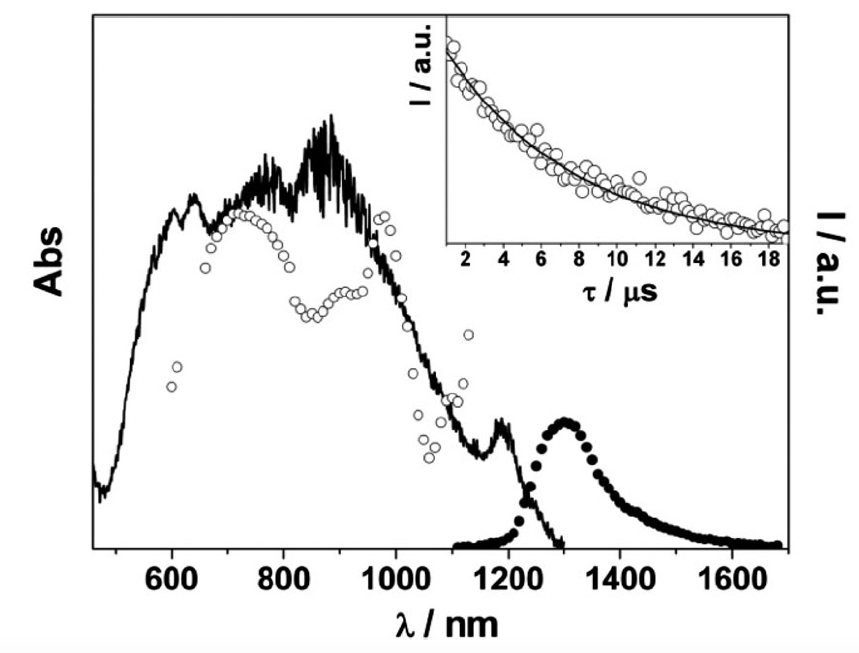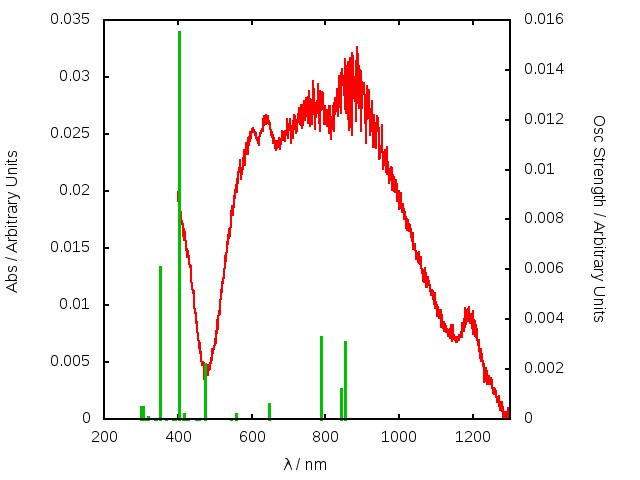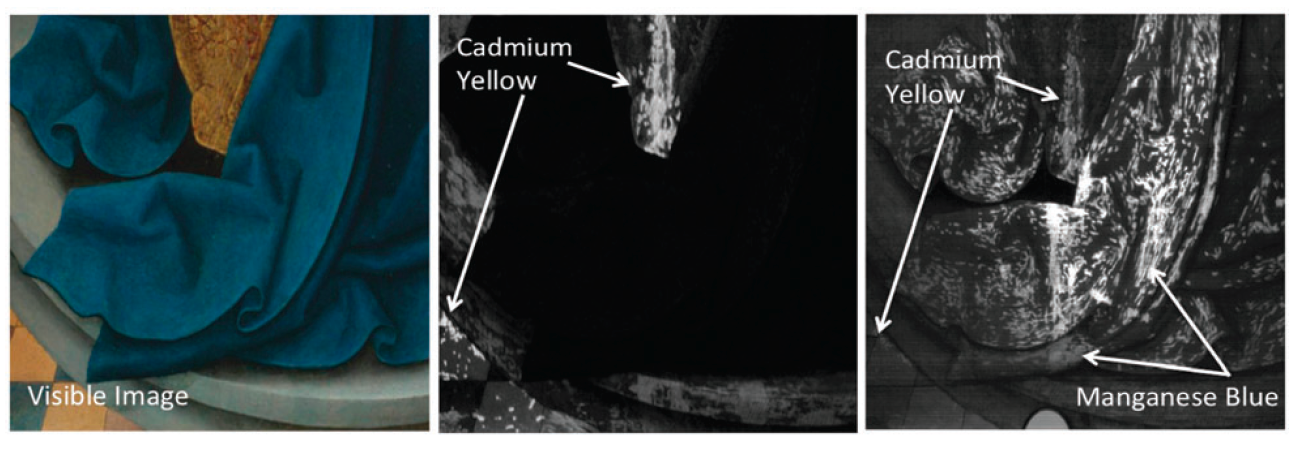This article discusses the properties of a paint pigment, manganese blue, and defines a method to map the presence of the pigment in works of art. It will help you understand the research the journal article is based on, and how to read and understand journal articles. The research article was originally published in our Chemical Communications journal.
Imaging, photophysical properties and DFT calculations of manganese blue (barium manganate(VI) sulphate) – a modern pigment
Click here to view the full article in the journal Chemical Communications
Authors: Gianluca Accorsi, a,b Giovanni Verri ,c Angela Acocella ,d Francesco Zerbetto ,d Giovanni Lerario ,e Giuseppe Gigli ,a,e,f David Saunders g and Rachel Billinge h
Why is this study important?
Manganese blue is barium manganate (VI) sulphate, an inorganic compound made of MnO42--doped BaSO4 crystals. 1 It is a green-blue pigment and was first discovered in 1907. Being chemically inert, insoluble in water and able to accelerate the drying of oil paints, it was used both as a blue pigment in works of art and in the restoration of paintings. 2 By the 1990s its production had stopped.
This study discusses the photo-induced luminescence properties of manganese blue in detail, and defines a methodology to map the presence of the pigment. Mapping pigments or painting materials through imaging is crucial for two reasons:
- it ensures that appropriate conservation treatments are used on art;
- it helps people understand the history behind a piece of art and how it was produced.
While manganese blue is a well-known pigment, and was sold as an artists’ pigment until the 1900s, it has never been found in a work of art. The imaging tool in this research allows the authors to rapidly investigate large areas of a painting, and attempt to ‘discover’ the presence of the pigment. Similar procedures have been successfully applied to another pigment - Egyptian blue - allowing the discovery of, for the first time, the use of pigments on the Parthenon sculptures.3 Many fields of conservation can benefit from imaging techniques, including authentication.
For this research it was important to understand the photochemical properties of the pigment to properly design the imaging system, and to suggest the potential use of the material in other fields.
Further information
- A themed collection of articles on ‘Molecular Analysis for Art, Archaeometry and Conservation (25 articles)’
- Selected further reading from RSC books:
- Science and Art: The Painted Surface
- Colour Chemistry: Edition 2
What is the objective?
The objective of this study was to provide a non-invasive tool for the identification and characterisation of manganese blue (barium manganate (VI) sulphate) in works of art. This was achieved by a computational investigation of the photo-induced luminescence properties of the inorganic compound.
What was their overall plan?
The overall plan can be summarised as follows:
- absorption spectra, and excitation and emission spectra (and related lifetime decays) measurements;
- a theoretical quantum mechanics model to describe and computationally predict the absorption spectrum;
- theoretical assignment of the absorption peaks and analysis of the spectrum;
- imaging: once the excitation and emission parameters had been defined, it was possible to select appropriate radiation sources and sensors, which are capable of capturing maps of distribution of the emission from a painting.
What was their procedure?
Absorption, excitation and emission spectra (and related lifetime decay) recording (Fig.1).4
The electronic absorption spectrum was recorded by inserting the solid-state sample into an integrating sphere setup equipped with a spectrophotometer ranging from the UV to NIR (200-3300 nm). The scattered light was subtracted from the sample signal (the spectrum of the sample support has been previously recorded) in order to determine the light absorbed by the chromophore only.
The excitation and emission spectra were obtained with a spectrofluorimeter by fixing the emission and excitation wavelengths. A 450W Xe Lamp was used as the light source, double grating monochromators as wavelength selectors (both in excitation and emission) and a NIR sensitive photodiode as the detector. Finally, the lifetime decay was calculated by fitting the exponential curve obtained by the single photon counting technique (a pulsed laser source at 637 nm as the light source).
From these optical measurements, important parameters were calculated, such as absorption range, photoluminescence quantum yield (PLQY) and colour output. These values are essential for an accurate characterization of the pigment.

Figure. 1 Absorbance (total reflection, full line), excitation (empty circle, em = 1300 nm) and emission (full circle, exc = 637 nm) spectra of powdered synthetic manganese-blue. Inset: luminescence decay (7.1 ms, exc = 637 nm).
Selection of an appropriate theoretical quantum mechanics approach for the description and reproduction of the absorption spectrum
In an attempt to determine the manganese blue optical structure, the authors conducted experiments with quantum mechanical calculations on the 3d1 electronic configuration of the manganate anion. Time-dependent density functional theory (TDDFT) methodology has proved to be a reliable method for calculating excitation energies for many organic and inorganic molecules. 5 In particular, Cramer and Truhlar reviewed density functional theory (DFT) and discovered that a large set of different functionals indicated the accuracy of this approach for the study of transition metal chemistry. They showed that the application of DFT to transition metal systems has become a well-established approach. They proved that the linear-response TDDFT method provides a useful model for reproducing and understanding the optical spectra of transition-metal complexes. However, as was emphasized by Sousa et al., 6 it is not easy to know beforehand which functional can be applied to a given case. Furthermore, for transition metal complexes, the choice of a proper basis set (a set of functions used in computational chemistry) for the description of the heavy atom, Mn in this case, is also important.
Theoretical assignment of the absorption peaks and interpretation of the spectrum
Despite the simple 3d1 electronic configuration of the MnO42- ion, the interpretation of the optical absorption spectrum of manganese blue required a detailed analysis. Calculations identified two ligand-to-metal charge transfer (LMCT) transitions in the near-IR region (800-900 nm) and below 600 nm. The calculated excited state energies of the three d-d transitions are consistent with both present and previous literature experimental data. The experimental absorption spectrum of the present study shows two additional bands in the region between 620-820 nm with respect to previous MnO42-resolved spectroscopy. The experimental absorption spectrum was even predicted by our DFT calculations, and is assigned to lower energy ligand-to-metal transitions or to a redistribution of the electron density between the oxygen and Mn(VI) atom, due to the mild ionic nature of the Mn-O bond.

Figure 2 . The experimental Mn-doped BaSO4 absorption spectrum (red line) and the stick theoretical TD-UB3LYP/6-31G* spectrum (green line); on the right y-axis, theoretical oscillator strengths are reported.
Imaging
The setup used for imaging is very simple. An InGaAs camera, sensitive to infrared radiation in the 700 nm to 1700 nm range, was used to record emissions from the pigment, which was irradiated with commercially available red, green and blue LEDs. 3 A Schott RG830 cut-on filter (50% transmission at 830 nm) was used in front of the lens of the camera to remove any infrared radiation in the 700 nm–800 nm range. For comparison, another image was taken using the same LEDs and a CCD camera, which is sensitive from 800-1000 nm. The luminescence of manganese blue at 1400 nm can be seen only with the InGaAs camera and not with the CCD camera. In contrast, the emission by cadmium yellow, another modern pigment with luminescence properties, can be seen in the 800-1000 nm range. 7

Figure. 3 : Visible-induced luminescence images of The Coronation of the Virgin by the Master of Cappenberg (NG 263) in the visible range (left), 800–1000 nm range (middle) and 800–1700 nm range (right).
What are the conclusions?
In conclusion, manganese blue - a blue pigment used in works of art from approximately 1935 to the 1990s - shows a broad light absorption (~ 500–1200 nm) and a NIR photoluminescence (1300 nm, PL = 0.5%) originating from 2E to 2T2 ligand-field (LF) transitions, according to the theoretical calculations.
Based on this analysis, it was possible to identify a non-invasive, portable imaging technique that could be used within a museum for mapping the pigment, both when used as a primary colorant or as a retouching pigment by conservators. Because of the well-documented history of the pigment, and its known dates of production and distribution, its identification as an original or added material on a work of art would assist in dating a work of art, any restoration or conservation efforts made to it, and help to assess the condition of a painting.
What are the next steps?
Following on from this research the authors have recently started a project entitled LuminArt - generously financed by the Leverhulme Trust. The main aims of the project are:
- to carry out a systematic investigation and create a database of the photoluminescence properties of a range of painting materials typically used in heritage objects, such as pigments, colorants, binders and conservation materials;
- to use these properties to establish what the most suitable luminescence imaging techniques for the study of artworks are;
- to develop these into imaging guidelines and interpretation tools suitable for use by a wide range of conservators, heritage professionals and scientists;
- to apply imaging guidelines and interpretation tools to real case studies;
- to disseminate the results to the heritage communities through the media, peer-reviewed publications and practical workshops and sessions;
- to establish if any of these materials could have interesting applications outside the world of the conservation of cultural heritage.
Authors affiliations
a Istituto Nanoscienze – Consiglio Nazionale delle Ricerche,
NNL c/o distretto tecnologico, Lecce, via Arnesano 16, 73100 Lecce, Italy.
E-mail: gianluca.accorsi@nano.cnr.it; Tel: +39 0832 1816242
b Istituto ISOF, Consiglio Nazionale delle Ricerche, 40129 Bologna, Italy.
E-mail: gianluca.accorsi@isof.cnr.it; Tel: +39 051 6399816
c The Courtauld Institute of Art, Somerset House, Strand, London, WC2R 0RN, UK.
E-mail: giovanni.verri@courtauld.ac.uk; Tel: +44 (0)2978482164
d Dipartimento di Chimica ‘‘G.Ciamician’’, Universita` di Bologna, Via F. Selmi 2,
40126, Bologna, Italy. E-mail: francesco.zerbetto@unibo.it,
angela.acocella3@unibo.it
e Center for Biomolecular Nanotechnology (CBN), Fondazione Istituto Italiano di
Tecnologia (IIT), Via Barsanti 1, Arnesano, 73010, Italy
f Department of Mathematics and Physics ‘‘Ennio De Giorgi’’, University of Salento,
Campus Universitario, via Monteroni, 73100 Lecce, Italy
g Department of Conservation and Scientific Research, British Museum,
Great Russell Street, London WC1B 3DG, UK
h Conservation Department, The National Gallery, Trafalgar Square,
London WC2N 5DN, UK
Abbreviations used in text
|
Abbreviation |
Name |
Links |
|
DFT |
Density functional theory |
Density functional theory for beginners |
|
LMCT |
Ligand-to-metal charge transfer |
Chemwiki - Metal to Ligand and Ligand to Metal Charge Transfer Bands |
|
LED |
Light-emitting diode |
|
|
LF |
Ligand-field |
|
|
NIR |
Near-infrared |
|
|
PLQY |
Photoluminescence quantum yield |
|
|
TDDFT |
Time-dependent density functional theory | Time-dependent density functional theory and how it is used |
|
UV |
Ultraviolet | Wikipedia - Ultraviolet |
References
1. R. Siddall, N. Eastaugh, V. Walsh, and T. Chapman, The Pigment Compendium, Butterworth-Heinemann, Oxford, UK, 1998.
2. T. W. Salter, Treatise on Colours and Pigments as used by Artists’, Winsor and Newton, London, 1869.
3. G. Accorsi, G. Verri, M. Bolognesi, N. Armaroli, C. Clementi, C. Miliani, and A. Romani, Chem. Comm. 2009, 3392-3394.
4. M. Montalti, and S. L. Murov, Handbook of photochemistry, 3rd ed., CRC/Taylor & Francis, Boca Raton, 2006.
5. T. C. Brunold, and H. U. Gudel, Inorg. Chem. 1997, 36, 1946-1954; M. J. Frisch, Gaussian 09, Revision B.01 Gaussian, Inc.: Wallingford CT, 2010; M. Couty, M. B. Hall, J. Comput. Chem. 1998, 17, 1359-1370.
6. S. F. Sousa, P. A. Fernandes, and M. J. Ramos, J. Phys. Chem. A 2007, 111, 10439-10452.
7. C. F. Bridgman, and H. L. Gibson, Studies in Conservation 1963, 8, 77–83.
Additional information
Journal articles made easy are journal articles from a range of Royal Society of Chemistry journals that have been re-written into a standard, accessible format. They contain links to the associated Chemistry World article, ChemSpider entries, related journal articles, books and Learn Chemistry resources such as videos of techniques, and resources on theory and activities. They should facilitate students understanding of scientific journal articles and how to extract and interpret the information in them.


















No comments yet